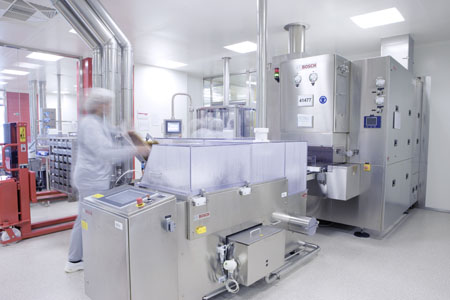As competition among contract manufacturers gets fiercer, it is important to stand out from the crowd. Quality and competitive pricing are now basic prerequisites. hameln pharma believes rapid service could be another key selling point.
Today, pharmaceutical companies have to show special abilities along with reliability in delivering supplies to compete within the marketplace. Those incapable of supplying what the market wants will rapidly lose market share to competitors, irrespective of the reasons underlying any such shortfall.
To guarantee their status as regular suppliers, many large pharmaceutical concerns have established back-up suppliers – usually contract manufacturing organisations (CMOs) – that can jump in and manufacture the desired product at short notice whenever a shortfall is foreseen. Key factors for selecting the back-up supplier include the speed, reliability and readiness with which customer wishes can be fulfilled. The importance of these factors is illustrated by a recent project carried out within hameln pharma.
The CMO, which has specialised in the contract manufacture of sterile liquids for 60 years, received an urgent request from an international pharmaceutical concern in February 2011. The customer placed an order for 500,000 vials of sodium chloride (NaCl) that it needed urgently or it would face losing substantial market share. For this reason, the delivery time for the product was a maximum of three months.
For hameln pharma this request posed a dual challenge. First, the product had to be established much more quickly than was normally the case. Second, the batches from hameln pharma could not differ in their overall make-up and composition from the batches produced by the customer in-house.
An initial thorough analysis of the requirements revealed that the solution desired by the customer differed substantially from the NaCl solution produced at hameln pharma as standard. This was true not only when considering the composition of the solution, but also when considering the customer-specific stopper-cap-vial combination.
Following a machine test performed at hameln pharma it rapidly became clear that the requirements of the customer could be fulfilled.
The validation work required was performed in record time. This included:
- Hazard Analyses and Critical Control Points (HACCP) and the resulting Corrective Action Plan (CAP), which established the measures for risk assessment
- Process validation
- Validation of the microbiological procedures
- Validation of the optical controls
Because of the high item number the product was to be checked using the fully automated optical monitoring system. For this reason the machine had to be validated in a product-specific manner so that, for example, the correct control program could be selected.
Since the vial supplier could not deliver with the same urgency as that offered by the CMO, the customer supplied the primary packaging material for the first five of the 10 batches to be produced. For hameln pharma this entailed additional effort in the manufacturing process, since the provided vials were packed differently from those normally used – an extra effort that the CMO, which prides itself on offering customer-specific solutions as standard, took within its stride.
Because no time was available for auditing any raw material suppliers, the raw materials were also supplied by the customer, as were the package inserts and the labels.
Because the customer wanted to hand over all the documentation, the CMO temporarily revised its internal processes to fulfil this requirement. As such, the customer merely signed a statement in which it confirmed that it had provided correct information upon which the manufacture of the product by the CMO could be based. Therefore no documents needed to be transferred between the customer and the contract manufacturer, as consistent with the internal procedures of the customer.
Even the late decision of the customer to transfer final release to the hands of the CMO did not endanger the timeline of the project. Thanks to good supplier relations, hameln pharma was also able at short notice to transfer methods to an external laboratory wherever it could not perform such methods itself. The final release was then carried out by the CMO’s Qualified Person.

Filling operation in the sterile facility
In the end it was able to deliver on time and at full capacity, and in so doing was able to protect its customer from defaulting on its supplies. Since the customer was convinced both of the quality of the product and of the implementation of the project, the CMO also received a follow-on order of similar magnitude.
Since the timescale for this follow-on order was rather less urgent, hameln pharma also assumed the procurement of raw materials as well as the purchasing of the vials and the remaining packaging material, offering the customer a comprehensive, worry-free package.
This example clearly shows that it is of key importance for contract manufacturers to be able to react quickly to specific customer requirements, and to be able to find solutions individualised and tailored towards them. Scheme F will ultimately not be of any use if the intention is to establish as a back-up supplier for a customer.




